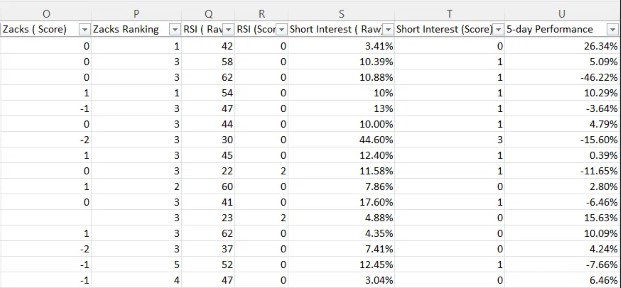
Maybe The Fed Needs To Hike Rates Again
That was our first thought when we saw that shares of a retailer had more than doubled in price since it missed earnings last quarter, ostensibly because one of its competitors was bought out. Our second thought was that it highlights the need to look at numbers in context sometimes, rather than always adhering to the same quantitative approach–even if that approach has done well for us recently, as we noted last week (“Waiting For The World To End“).
Let’s recap our approach first, and then explain why we’re deviating from it in this case.
Our Ten Signals For Evaluating Earnings Trades
We use these ten signals for evaluating earnings trades:
- LikeFolio’s earnings score based on social data. The higher the number, the more bullish, the lower (more negative) the number, the more bearish.
- Portfolio Armor’s gauge of options market sentiment.
- Chartmill’s Setup rating. On a scale of 0-10, this is a measure of technical consolidation. For bullish trades, we want a high setup rating; for bearish trades, a lower one.
- Chartmill’s Valuation rating. On a scale of 0-10, this is a measure of fundamental valuation incorporating common rations like P/E, PEG, EBITDA/Enterprise Value, etc. For bullish trades, the higher the better the Valuation rating the better; for bearish trades, the reverse.
- Zacks Earnings ESP (Expected Surprise Prediction). This is a ratio of the most accurate analyst’s earnings estimate versus the consensus estimate.
- Zacks Ranking. A number from 1 to 5 with 1 representing their 5% most bullish stocks, 2 representing their next 20%, 3 the middle 50%, and so on.
- The Piotroski F-Score. A measure of financial strength on a scale from 0-9, with 9 being best.
- Recent insider transactions.
- RSI (Relative Strength Index). A technical measure of whether a stock is overbought or oversold. We’re looking for RSI levels below 70 for bullish trades and above 30 for bearish ones.
- Short Interest.
For most of those signals, we give a numerical rating from -2 (very bearish) to +2 (very bullish), and for each stock we evaluate each week (not just the ones we place trades on), we enter the data above in a spreadsheet, and at the end of the week, we record each stock’s 5-day return.

And we’re using their relative outperformance or underperformance versus all of the stocks that we’ve analyzed to adjust our weightings of each metric to determine which stocks we should be bullish or bearish on ahead of earnings.
The Retailer We’re Betting Against
The number in parentheses represents our composite score for a stock, based on the signals: higher = more bullish, and lower (more negative) = more bearish.
Bearish Stock #1 (4.9)
- Social data: -13.
- PA Options sentiment: Very Bearish.
- Setup rating: 5
- Valuation rating: 3
- F-Score: 6
- Recent insider transaction(s): Net open market purchases in September, but at less than a third of the current share price.
- Zacks ESP: 0%
- Zacks Ranking: 3
- RSI: 81
- Short Interest: 18.99%
Why We’re Betting Against A Bullish Composite Score
The recent insider transaction contributes 2.8 points to the 4.9 point composite score because, in our data, the average stock with net insider buying out performs the average stock without it by 2.8x during earnings week. But we have a relatively small sample of stocks with net insider buying, and in this case, the stock has climbed more than 200% since the insider bought his shares in September.
Also, we would consider an RSI of 81 to be very bearish (since it suggests the stock is extremely overbought), but it doesn’t impact our composite score here because we have never had a stock with an RSI that high before earnings. So based on all of that, we’re betting against this retailer, despite its high composite score. If you’re subscribed to our trading Substack/occasional email list below, check your inbox for our trade on this stock this afternoon. If you’re not subscribed yet, you can do so below.
If You Want To Stay In Touch
You can scan for optimal hedges for individual securities, find our current top ten names, and create hedged portfolios on our website. You can also follow Portfolio Armor on Twitter here, or become a free subscriber to our trading Substack using the link below (we’re using that for our occasional emails now).


